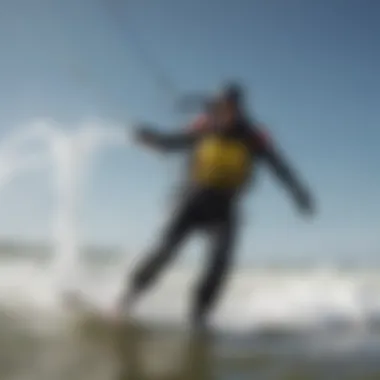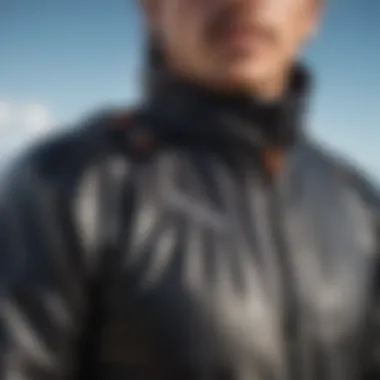Unveiling the Advantages of Utilizing a Drysuit for Kitesurfing


Equipment Reviews
When it comes to kitesurfing, having the right gear can make all the difference in your experience on the water. Let's delve into the world of kites, where we will provide an in-depth overview of the latest models available. From kite shapes to sizes, materials, and brands, we will explore every aspect to help you make an informed decision when selecting your next kite. Moving on to boards, we will review the diverse selection of kiteboarding boards, including twintips and directional boards. Our focus will be on design, construction, and how each type suits different riding styles.
Travel Destinations
As kitesurfers, we are always on the lookout for new and exciting spots to explore. In this section, we will highlight top kitesurfing destinations worldwide. From the windy shores of Tarifa to the crystal-clear waters of the Maldives, we will provide detailed information on wind conditions, water quality, local amenities, and nearby attractions. For the adventurous souls seeking a unique experience, we will also uncover hidden gems and underrated kitesurfing spots off the beaten path.
Techniques and Tutorials
Whether you are a newbie looking to learn the ropes or an experienced rider aiming to master advanced skills, this section has got you covered. Our beginner guides will offer step-by-step tutorials on the basics of kitesurfing and kiteboarding. You can expect to find detailed instructions on launching, riding, turning, and landing techniques tailored for novices. For the adrenaline junkies hungry for a challenge, we will delve into advanced maneuvers like jumps, tricks, wave riding, and freestyle techniques suitable for experienced riders.
Safety Guidelines
Safety is paramount when it comes to kitesurfing and kiteboarding. Understanding how weather conditions impact your session is crucial. In this section, we will educate you on the effects of wind, currents, tides, and weather patterns on your safety. Stay prepared with our tips on assessing and adapting to changing conditions. Additionally, we will outline essential emergency protocols, including safety measures, rescue tactics, and procedures to handle common accidents on the water. Remember, regular equipment checks and maintenance routines are key to a safe kitesurfing experience.
The significance of incorporating a drysuit into one's kitesurfing gear cannot be overstated. Kitesurfing, being an exhilarating water sport that combines aspects of surfing, windsurfing, and paragliding, demands equipment that ensures both performance and safety. A drysuit emerges as a crucial component in kitesurfing gear due to its ability to provide thermal insulation, waterproof protection, enhanced comfort, and safety benefits. This article delves into the manifold advantages a drysuit offers to kitesurfers, highlighting how it can substantially elevate their kitesurfing experience. We will uncover the nuances of thermal insulation provided by drysuits, discuss the waterproof protection they offer against the elements, explore the enhanced comfort they bring to long hours on the water, and elaborate on the safety benefits that can make a significant difference in emergency situations. By understanding the benefits of using a drysuit for kitesurfing, enthusiasts can make informed decisions that enhance their performance and enjoyment on the waves.
Understanding Drysuits
Understanding drysuits is paramount in comprehending the advantages they offer when kitesurfing. A drysuit is a specialized garment designed to provide insulation and waterproof protection to the wearer, especially in extreme aquatic conditions. As kitesurfing involves exposure to wind, water, and varying temperatures, having a suitable drysuit can significantly enhance the overall experience and safety of the activity. By understanding the different types of drysuits available, their key features, and how they cater to individual needs and preferences, kitesurfers can make informed decisions to optimize their performance and comfort.
What is a Drysuit?
A drysuit is a full-body suit typically made of waterproof material, such as Gore-Tex, neoprene, or a combination of fabrics, that seals in the wearer's body heat while keeping water out. Unlike wetsuits that allow a thin layer of water to enter and warm against the skin, drysuits prevent water from penetrating, ensuring the wearer stays dry and warm even in cold, windy conditions. This preservation of body heat is crucial for activities like kitesurfing where prolonged exposure to water can lead to hypothermia.


Types of Drysuits
Breathable Drysuits
Breathable drysuits are crafted using advanced materials that allow moisture and perspiration to escape while preventing water from seeping in. This breathability feature enhances comfort during physical exertion, making them ideal for kitesurfing where movement and flexibility are essential. Breathable drysuits are often preferred for their ability to regulate body temperature and reduce overheating, contributing to a more enjoyable and performance-driven experience on the water.
Neoprene Drysuits
Neoprene drysuits, constructed from a thick, insulating material, offer excellent warmth retention in cold water conditions. The flexibility of neoprene provides a snug fit that effectively traps body heat, making them a popular choice for kitesurfers navigating cooler climates or longer sessions. While neoprene drysuits provide exceptional insulation, they may limit mobility compared to other types, which is a factor to consider based on individual preferences and kitesurfing styles.
Hybrid Drysuits
Hybrid drysuits combine the benefits of breathable and neoprene materials, offering a versatile solution for varying kitesurfing environments. By incorporating breathable panels for enhanced comfort and mobility and neoprene sections for optimal insulation, hybrid drysuits provide a balanced approach to thermal regulation and performance. This combination caters to diverse preferences among kitesurfers, allowing them to adapt to changing weather conditions and water temperatures effortlessly.
Key Features of a Drysuit
Seals and Cuffs
The seals and cuffs of a drysuit play a critical role in maintaining a watertight barrier to protect the wearer from water entry. Good quality seals ensure a snug fit around the wrists, neck, and ankles, preventing water from seeping in even during strenuous movements. Properly sealed cuffs and neck contribute to overall comfort and insulation, vital for a seamless kitesurfing experience.
Zippers and Closures
Zippers and closures on a drysuit are designed to create a secure closure system that is easy to put on and take off while ensuring water integrity. High-quality zippers with protective flaps or covers minimize the risk of water leakage, providing added assurance during high-velocity water sports like kitesurfing. Functional closures enhance the watertight seal of the drysuit, offering convenience and peace of mind to the wearer throughout their session.
Materials Used


The choice of materials in a drysuit significantly impacts its performance, durability, and comfort. Common materials like Gore-Tex, neoprene, and hybrid fabric combinations each offer distinct benefits in terms of insulation, breathability, and flexibility. Understanding the properties of these materials helps kitesurfers select a drysuit that aligns with their preferences and requirements for different kitesurfing conditions. Choosing the right material ensures optimal functionality and comfort while maximizing the benefits of using a drysuit for kitesurfing.
Benefits of Using a Drysuit
The topic of benefits related to using a drysuit in kitesurfing is of paramount importance within the context of this article. Diving into the realm of kitesurfing demands a thorough understanding of the equipment involved, and the drysuit stands out as a critical element that can profoundly impact the overall kitesurfing experience. The significance of exploring the benefits lies in illuminating the advantages and practical implications that a drysuit offers to kitesurfers. From enhancing thermal insulation to providing waterproof protection and elevating comfort levels, a drysuit serves as a multifaceted tool that not only optimizes performance but also ensures the safety and well-being of kitesurfing enthusiasts. As we dissect the distinct benefits associated with using a drysuit, considerations such as material quality, design features, and functionality will be meticulously examined to provide a holistic understanding of why this specialized gear is a game-changer in the world of kitesurfing.
Thermal Insulation
When delving into the realm of thermal insulation concerning drysuits for kitesurfing, the critical focus revolves around the ability of these specialized garments to regulate body temperature in diverse environmental conditions. The efficiency of a drysuit in retaining heat and preventing heat loss becomes a pivotal factor in ensuring that kitesurfers maintain optimum comfort levels during sessions in cold waters or inclement weather scenarios. The utilization of advanced materials with insulating properties, coupled with innovative design techniques, equips drysuits to combat external elements and provide kitesurfers with a cozy refuge amidst challenging conditions. Whether braving frigid ocean waters or navigating through wind-whipped terrains, the presence of superior thermal insulation in a drysuit becomes a defining factor in sustaining performance and prolonging kitesurfing excursions without compromising bodily warmth.
Waterproof Protection
The aspect of waterproof protection in the realm of drysuit functionality underscores the fundamental necessity of shielding kitesurfers against the infiltration of water during their high-energy aquatic pursuits. A drysuit's capability to repel water and create a robust barrier between the wearer's body and the external environment is instrumental in fostering dryness and comfort throughout kitesurfing endeavors. By employing cutting-edge technologies in seam construction, fabric treatments, and waterproof seals, drysuits excel in mitigating water entry and fortifying the kitesurfer's resilience against moisture intrusion. This waterproof prowess not only enhances the overall kitesurfing experience by averting discomfort and chafing but also acts as a vital safety feature by minimizing the risks associated with prolonged exposure to wet conditions, thereby promoting sustained performance and agility.
Enhanced Comfort
In the realm of enhanced comfort facilitated by drysuits in kitesurfing, the emphasis is placed on optimizing the wearer's physical ease, mobility, and overall satisfaction during extended sessions on the water. The ergonomic design elements and tailored construction of drysuits aim to deliver a snug yet flexible fit that promotes unrestricted movement and minimizes bulkiness, allowing kitesurfers to maneuver with precision and agility. The incorporation of soft, breathable fabrics, strategically placed zippers, and customizable features accentuates the user's comfort levels by reducing friction, accommodating various body shapes, and enhancing ventilation to prevent overheating. By prioritizing comfort as a fundamental attribute, drysuits not only augment the pleasure derived from kitesurfing but also contribute to sustained performance levels by ensuring that distractions due to discomfort are minimized, enabling kitesurfers to focus on honing their skills and exploring the thrill of the sport with unparalleled ease.
Safety Benefits
When dissecting the safety benefits afforded by the utilization of drysuits in kitesurfing, the discussion transcends beyond mere functionality and delves into the realm of risk mitigation and emergency preparedness. Drysuits act as a dependable ally in safeguarding kitesurfers against sudden temperature drops, adverse weather conditions, and unforeseen accidents by serving as a protective barrier that shields the body from external elements and maintains core temperature stability. This safeguarding effect extends beyond insulation and comfort, as the buoyancy properties of certain drysuit variants contribute to floatation assistance in case of immersion incidents, providing an additional layer of safety and reassurance to kitesurfers navigating challenging waters. Furthermore, the visibility-enhancing features often integrated into drysuit designs enhance the wearer's presence in the water, facilitating quicker detection and rescue during emergencies. By combining advanced safety mechanisms with functional excellence, drysuits emerge as indispensable components in the kitesurfer's arsenal, amplifying security measures and instilling confidence in undertaking kitesurfing adventures with peace of mind.
Choosing the Right Drysuit
Choosing the right drysuit is a pivotal decision when engaging in kitesurfing, as it directly impacts your comfort, safety, and overall performance on the water. An ill-fitting drysuit can lead to discomfort, restricted movement, and reduced thermal insulation, jeopardizing your kitesurfing experience. Therefore, meticulous attention to detail is essential when selecting the ideal drysuit for your needs. Consider factors such as material, construction, and features to ensure a perfect fit that caters to your kitesurfing style and environmental conditions.


Fit and Sizing
The fit and sizing of a drysuit are paramount aspects that determine its effectiveness and your overall comfort while kitesurfing. A well-fitted drysuit should offer freedom of movement without excess fabric that may hinder your agility on the board. Pay close attention to the size charts provided by manufacturers to select the right size based on your measurements, ensuring a snug but not restrictive fit. Additionally, consider the layering you may need underneath the drysuit for added warmth or versatility, and choose a size that accommodates this without compromising mobility.
Budget Considerations
When exploring drysuit options for kitesurfing, budget considerations play a significant role in the decision-making process. While investing in a high-quality drysuit is crucial for optimal performance and durability, it is important to strike a balance between cost and features. Evaluate your kitesurfing frequency, the conditions you typically encounter, and your long-term commitment to the sport to determine the most suitable budget for your drysuit purchase. Keep in mind that a quality drysuit is a long-term investment that can enhance your kitesurfing experience and provide reliable protection against the elements.
Brand and Quality
The brand and quality of a drysuit are indicative of its performance, durability, and overall value for kitesurfing. Opting for well-established brands known for their expertise in watersports gear can offer assurance in terms of product quality and reliability. Consider factors such as seam construction, material technology, and feedback from fellow kitesurfers when assessing the quality of a drysuit. While brand reputation can influence your purchase decision, prioritize the features and functionality that align with your specific kitesurfing needs to ensure a satisfying and effective choice of drysuit.
Maintenance and Care Tips
In the realm of kitesurfing, the topic of Maintenance and Care Tips stands as a paramount consideration for enthusiasts looking to ensure the longevity and optimal performance of their equipment. As we scrutinize the significance of maintaining kitesurfing gear, the spotlight naturally shifts towards drysuits, instrumental in providing comfort and protection for riders braving the elements. A meticulous approach to maintenance not only prolongs the lifespan of the drysuit but also upholds its functionality under demanding conditions. Through a disciplined regimen of care, kitesurfers can safeguard their investment and guarantee uninterrupted enjoyment of their beloved water sport.
Cleaning and Storage
Delving into the sphere of drysuit care unveils the pivotal practices of cleaning and storage, integral steps in preserving the integrity of this specialized garment. Cleaning the drysuit meticulously dislodges salt, sand, and other debris accumulated during kitesurfing sessions, ensuring that the fabric and materials retain their quality. Impeccable hygiene practices not only contribute to the longevity of the drysuit but also prevent foul odors and bacterial growth
Repair and Maintenance
In the realm of extreme sports, the resilience and durability of equipment play a fundamental role in ensuring the safety and enjoyment of participants. When delving into the domain of kitesurfing, the same principles apply, with a keen focus on the repair and maintenance of essential gear like drysuits. Prioritizing prompt and effective repairs can prevent minor issues from escalating into major setbacks, safeguarding both the functionality and protective capabilities of the drysuit. Regular maintenance can unearth underlying problems and preemptively address wear and tear, allowing kitesurfers to engage in their adrenaline-fueled pursuit with confidence and security.
Conclusion
In wrapping up this comprehensive exploration of the benefits of using a drysuit for kitesurfing, it becomes evident that the conclusion serves as a pivotal component in understanding the significance of integrating this gear into one's kitesurfing arsenal. The drysuit inherently represents more than just attire; it symbolizes a fusion of advanced technology and practicality, designed to enhance the entire kitesurfing experience.
Delving into the specifics, the conclusion encapsulates a culmination of thermal insulation, waterproof protection, enhanced comfort, and safety benefits outlined throughout the article. It acts as a compass guiding kitesurfers towards a well-rounded understanding of why a drysuit goes beyond being a mere accessory, transitioning into a crucial tool for optimizing performance while ensuring comfort and safety in the unpredictable waters.
Moreover, the conclusion reiterates the key message that investing in a high-quality drysuit is a strategic step towards elevating one's kitesurfing adventures. By underlining the various advantages such as extended kitesurfing seasons in colder climates, protection against harsh elements, and flexibility for diverse kitesurfing styles, it emphasizes the comprehensive nature of the benefits reaped from donning a drysuit.
From a safety standpoint, the conclusion imparts crucial insights into how a drysuit serves as a protective barrier against hypothermia and hazardous conditions, reinforcing the importance of prioritizing safety while engaging in extreme water sports like kitesurfing. Additionally, it underscores the role of comfort and mobility in maximizing performance and enjoyment, shedding light on the holistic advantages that come with using a drysuit during kitesurfing expeditions.







